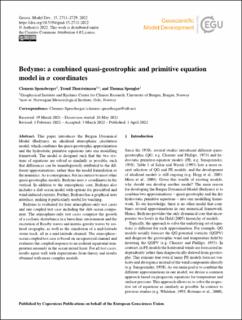| dc.contributor.author | Spensberger, Clemens | |
| dc.contributor.author | Thorsteinsson, Trond | |
| dc.contributor.author | Spengler, Thomas | |
| dc.date.accessioned | 2022-08-09T10:49:52Z | |
| dc.date.available | 2022-08-09T10:49:52Z | |
| dc.date.created | 2022-06-09T18:05:44Z | |
| dc.date.issued | 2022 | |
| dc.identifier.issn | 1991-959X | |
| dc.identifier.uri | https://hdl.handle.net/11250/3010773 | |
| dc.description.abstract | This paper introduces the Bergen Dynamical Model (Bedymo), an idealized atmospheric circulation model, which combines the quasi-geostrophic approximation and the hydrostatic primitive equations into one modelling framework. The model is designed such that the two systems of equations are solved as similarly as possible, such that differences can be unambiguously attributed to the different approximations, rather than the model formulation or the numerics. As a consequence, but in contrast to most other quasi-geostrophic models, Bedymo uses σ coordinates in the vertical. In addition to the atmospheric core, Bedymo also includes a slab ocean model with options for prescribed and wind-induced currents. Further, Bedymo has a graphical user interface, making it particularly useful for teaching.
Bedymo is evaluated for four atmosphere-only test cases and one coupled test case including the slab ocean component. The atmosphere-only test cases comprise the growth of a cyclonic disturbance in a baroclinic environment and the excitation of Rossby waves and inertia–gravity waves by isolated orography, as well as the simulation of a mid-latitude storm track, all in a mid-latitude channel. The atmosphere–ocean coupled test case is based on an equatorial channel and evaluates the coupled response to an isolated equatorial temperature anomaly in the ocean mixed layer. For all test cases, results agree well with expectations from theory and results obtained with more complex models. | en_US |
| dc.language.iso | eng | en_US |
| dc.publisher | Copernicus | en_US |
| dc.rights | Navngivelse 4.0 Internasjonal | * |
| dc.rights.uri | http://creativecommons.org/licenses/by/4.0/deed.no | * |
| dc.title | Bedymo: A combined quasi-geostrophic and primitive equation model in σ coordinates | en_US |
| dc.type | Journal article | en_US |
| dc.type | Peer reviewed | en_US |
| dc.description.version | publishedVersion | en_US |
| dc.rights.holder | Copyright 2022 the authors | en_US |
| cristin.ispublished | true | |
| cristin.fulltext | original | |
| cristin.qualitycode | 2 | |
| dc.identifier.doi | 10.5194/gmd-15-2711-2022 | |
| dc.identifier.cristin | 2030618 | |
| dc.source.journal | Geoscientific Model Development | en_US |
| dc.source.pagenumber | 2711-2729 | en_US |
| dc.identifier.citation | Geoscientific Model Development. 2022, 15 (6), 2711-2729. | en_US |
| dc.source.volume | 15 | en_US |
| dc.source.issue | 6 | en_US |

